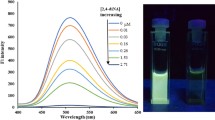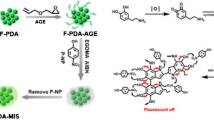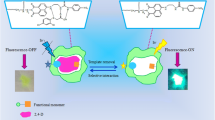Abstract
A novel molecularly imprinted fluorescent sensor for the determination of 4-nitroaniline (4-NA) was synthesized via free radical polymerization with 3-[(7-methoxy-2-oxo-2H-chromen-4-yl)methyl]-1-vinyl-1H-imidazol-3-ium bromide as the fluorescence functional monomer, 4-NA as the template molecule, ethylene glycol dimethacrylate as the cross-linker, and 2,2′-azo(bisisobutyronitrile) as the initiator. The obtained fluorescent poly(ionic liquid) was characterized through Fourier transform infrared, scanning electron microscopy, Brunauer–Emmett–Teller analysis, and fluorescence spectrophotometry. The fluorescent sensor had high fluorescence intensity, short detection time (0.5 min), good selectivity, and excellent sensitivity (limit of detection = 0.8 nM) for 4-NA, with good linear relationships of 2.67–10,000 nM. The practical applicability of the fluorescence sensor in detecting 4-NA in industrial wastewater and spiked environmental water was demonstrated, and a satisfactory result was obtained.

Highly sensitive and selective detection of 4-nitroaniline in water by a novel fluorescent sensor based on molecularly imprinted poly(ionic liquid)






Similar content being viewed by others
References
Benigni R, Passerini L. Carcinogenicity of the aromatic amines: from structure–activity relationships to mechanisms of action and risk assessment. Mutat Res. 2002;511(3):191–206.
Ahmad R, Tripathy N, Ahn MS, Hahn YB. Development of highly-stable binder-free chemical sensor electrodes for p-nitroaniline detection. J Colloid Interface Sci. 2017;494:300–6.
Zheng K, Zhang T, Lin P, Han Y, Li H, Ji R, et al. 4-Nitroaniline degradation by TiO2 catalyst doping with manganese. J Chem. 2015:1–6.
Niazi A, Ghasemi J, Yazdanipour A. Simultaneous spectrophotometric determination of nitroaniline isomers after cloud point extraction by using least-squares support vector machines. Spectrochim Acta A. 2007;68(3):523–30.
Hasani M, Emami F. Evaluation of feed-forward back propagation and radial basis function neural networks in simultaneous kinetic spectrophotometric determination of nitroaniline isomers. Talanta. 2008;75(1):116–26.
Wang M, De Vivo B, Lu W, Muniz-Miranda M. Sensitive surface-enhanced Raman scattering (SERS) detection of nitroaromatic pollutants in water. Appl Spectrosc. 2014;68(7):784–8.
Zhang Y, Su K, Ha Y, Chen S, Chen W, Sun C, et al. Silver molecularly imprinting polymer for the determination of p-nitroaniline by surface enhanced Raman scattering. Anal Lett. 2019;52(12):1888–99.
Laghrib F, Farahi A, Bakasse M, Lahrich S, El Mhammedi MA. Chemical synthesis of nanosilver on chitosan and electroanalysis activity against the p-nitroaniline reduction. J Electroanal Chem. 2019;845:111–8.
Bakhsh EM, Ali F, Khan SB, Marwani HM, Danish EY, Asiri AM. Copper nanoparticles embedded chitosan for efficient detection and reduction of nitroaniline. Int J Biol Macromol. 2019;131:666–75.
Laghrib F, Farahi A, Bakasse M, Lahrich S, El Mhammedi MA. Voltammetric determination of nitro compound 4-nitroaniline in aqueous medium at chitosan gelified modified carbon paste electrode (CS@CPE). Int J Biol Macromol. 2019;131:1155–61.
Qian L, Hong H, Han M, Xu C, Wang S, Guo Z, et al. A ketone-functionalized carbazolic porous organic framework for sensitive fluorometric determination of p-nitroaniline. Microchim Acta. 2019;186(7):457.
Cao Y, Wang S, Wu W, Peng H, Yu Y, Zhu D. Cucurbit[6]uril modified CdTe quantum dots fluorescent probe and its selective analysis of p-nitroaniline in environmental samples. Talanta. 2019;199:667–73.
Tong C, Guo Y, Liu W. Simultaneous determination of five nitroaniline and dinitroaniline isomers in wastewaters by solid-phase extraction and high-performance liquid chromatography with ultraviolet detection. Chemosphere. 2010;81(3):430–5.
Xiao P, Bao C, Jia Q, Su R, Zhou W, Jia J. Determination of nitroanilines in hair dye using polymer monolith microextraction coupled with HPLC. J Sep Sci. 2011;34(6):675–80.
Zhao S, Ding J-G, Zheng T-R, Li K, Li B-L, Wu B. The 3D and 2D cadmium coordination polymers as luminescent sensors for detection of nitroaromatics. J Lumin. 2017;188:356–64.
Wu P, Liu Y, Li Y, Jiang M, Li X-l, Shi Y, et al. A cadmium(ii)-based metal–organic framework for selective trace detection of nitroaniline isomers and photocatalytic degradation of methylene blue in neutral aqueous solution. J Mater Chem A. 2016;4(42):16349–55.
Guo X, Lv J, Zhang W, Wang Q, He P, Fang Y. Separation and determination of nitroaniline isomers by capillary zone electrophoresis with amperometric detection. Talanta. 2006;69(1):121–5.
Sanchis Y, Coscolla C, Yusa V. Comprehensive analysis of photoinitiators and primary aromatic amines in food contact materials using liquid chromatography high-resolution mass spectrometry. Talanta. 2019;191:109–18.
Luongo G, Iadaresta F, Moccia E, Ostman C, Crescenzi C. Determination of aniline and quinoline compounds in textiles. J Chromatogr A. 2016;1471:11–8.
Kampfer P, Crettaz S, Nussbaumer S, Scherer M, Krepich S, Deflorin O. Quantitative determination of 58 aromatic amines and positional isomers in textiles by high-performance liquid chromatography with electrospray ionization tandem mass spectrometry. J Chromatogr A. 2019;1592:71–81.
Tolgyesi A, Sharma VK. Quantification of aromatic amines derived from azo colorants in textile by ion-pairing liquid chromatography tandem mass spectrometry. J Chromatogr B. 2020;1137:121957.
The Huy B, Seo MH, Zhang X, Lee YI. Selective optosensing of clenbuterol and melamine using molecularly imprinted polymer-capped CdTe quantum dots. Biosens Bioelectron. 2014;57:310–6.
Liu G, Huang X, Li L, Xu X, Zhang Y, Lv J, et al. Recent advances and perspectives of molecularly imprinted polymer-based fluorescent sensors in food and environment analysis. Nanomaterials (Basel). 2019;9(7):1030.
Hallett JP, Welton T. Room-temperature ionic liquids: solvents for synthesis and catalysis. 2. Chem Rev. 2011;111(5):3508–76.
Sing KS. Reporting physisorption data for gas/solid systems with special reference to the determination of surface area and porosity (recommendations 1984). Pure Appl Chem. 1985;57(4):603–19.
Li B, Huang X, Liang L, Tan B. Synthesis of uniform microporous polymer nanoparticles and their applications for hydrogen storage. J Mater Chem. 2010;20(35):7444–50.
Zhu X, Yu J, Jiang C, Cheng B. Enhanced room-temperature HCHO decomposition activity of highly-dispersed Pt/Al2O3 hierarchical microspheres with exposed {110} facets. J Ind Eng Chem. 2017;45:197–205 2015.
Laghrib F, Ajermoun N, Hrioua A, Lahrich S, Farahi A, El Haimouti A, et al. Investigation of voltammetric behavior of 4-nitroaniline based on electrodeposition of silver particles onto graphite electrode. Ionics. 2018;25(6):2813–21.
Wei F, Cai X, Nie J, Wang F, Lu C, Yang G, et al. A 1,2,3-triazolyl based conjugated microporous polymer for sensitive detection of p-nitroaniline and Au nanoparticle immobilization. Polym Chem. 2018;9(27):3832–9.
Lu X, Yang Y, Zeng Y, Li L, Wu X. Rapid and reliable determination of p-nitroaniline in wastewater by molecularly imprinted fluorescent polymeric ionic liquid microspheres. Biosens Bioelectron. 2018;99:47–55.
Ji NN, Shi ZQ, Hu HL, Zheng HG. A triphenylamine-functionalized luminescent sensor for efficient p-nitroaniline detection. Dalton Trans. 2018;47(21):7222–8.
Chakraborty G, Das P, Mandal SK. Strategic construction of highly stable metal-organic frameworks combining both semi-rigid tetrapodal and rigid ditopic linkers: selective and ultrafast sensing of 4-nitroaniline in water. ACS Appl Mater Interfaces. 2018;10(49):42406–16.
Shu T, Wang N, Li Y, Fu D, Fan H, Luo M, et al. A new three-dimensional Cd(II) metal-organic framework for highly selective sensing of Fe3+ as well as nitroaromatic compounds. ChemistrySelect. 2017;2(36):12046–50.
Laghrib F, Boumya W, Lahrich S, Farahi A, El Haimouti A, El Mhammedi MA. Electrochemical evaluation of catalytic effect of silver in reducing 4-nitroaniline: analytical application. J Electroanal Chem. 2017;807:82–7.
Funding
This research is supported by the National Natural Science Foundation of China (Nos. 21677060 and 51503079), the Public Welfare Technology Research Project of Zhejiang Province (Nos. LGF18B050004 and LGC19B050007), the Natural Science Foundation of Zhejiang Province (No. LY20B050009), and the Science and Technology Plan Project of Jiaxing City, China (Nos. 2017AY33034 and 2018AY11002).
Author information
Authors and Affiliations
Corresponding authors
Ethics declarations
Industrial wastewater was provided by a chemical factory in Jiangsu Province (China), and it was authorized by the chemical factory to be used for the study.
Conflict of interest
The authors declare that they have no conflict of interest.
Additional information
Publisher’s note
Springer Nature remains neutral with regard to jurisdictional claims in published maps and institutional affiliations.
Electronic supplementary material
ESM 1
(PDF 431 kb).
Rights and permissions
About this article
Cite this article
Xie, W., Zhang, J., Zeng, Y. et al. Highly sensitive and selective detection of 4-nitroaniline in water by a novel fluorescent sensor based on molecularly imprinted poly(ionic liquid). Anal Bioanal Chem 412, 5653–5661 (2020). https://doi.org/10.1007/s00216-020-02785-4
Received:
Revised:
Accepted:
Published:
Issue Date:
DOI: https://doi.org/10.1007/s00216-020-02785-4




